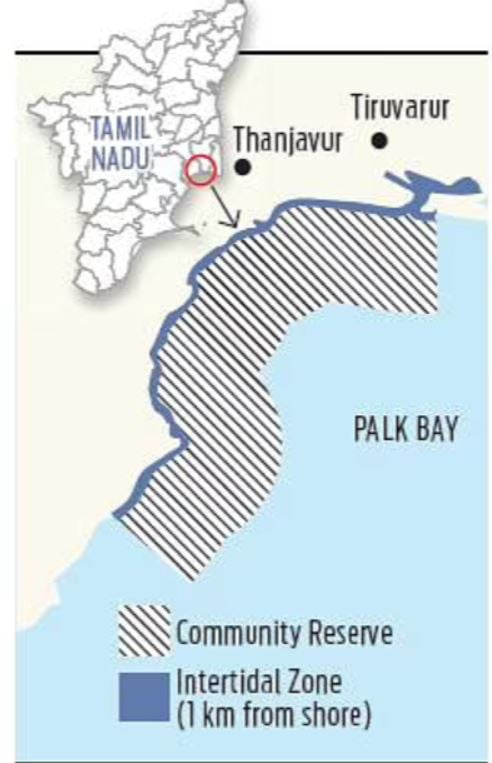UPSC Articles
(Down to Earth: Wildlife & Biodiversity)
Feb 25: Better late than never: Experts on Tamil Nadu’s decision to go ahead with dugong reserve in Palk Bay- https://www.downtoearth.org.in/news/wildlife-biodiversity/better-late-than-never-experts-on-tamil-nadu-s-decision-to-go-ahead-with-dugong-reserve-in-palk-bay-81712
TOPIC:
- GS-3: Conservation
Better late than never: Experts on Tamil Nadu’s decision to go ahead with dugong reserve in Palk Bay
Context: Tamil Nadu government has recently taken a decision to go ahead with the establishment of a conservation reserve for the elusive dugong (Dugong dugon), a sirenian species native to parts of the Indian littoral.
- The Tamil Nadu government had announced September 3, 2021 that a dugong conservation reserve would be established in the Gulf of Mannar, Palk Bay between India and Sri Lanka, for the conservation of the animals.
- The TN government also accorded administrative approval for a sum of Rs 25 lakh for the preparation of a detailed project report and carrying out baseline field studies.
About Dugong
- Dugongs are a Schedule I animal under the Wildlife (Protection) Act, 1972. Legally, it was given the highest protection.
- The dugong , also called the sea cow, is a herbivorous mammal.
- It is the only living representative of the once-diverse family Dugongidae.
- The dugong is strictly a marine mammal.
- They graze on seagrass and come to the surface to breathe.
- They are found in over 30 countries and in India are seen in the Gulf of Mannar, Gulf of Kutch, Palk Bay, and the Andaman and Nicobar Islands.
- According to Wildlife Institute of India (WII) estimates, only 200-250 Dugongs are left in the wild, of which 150 are found in the Palk Bay and Gulf of Mannar in Tamil Nadu.
- Threats:
-
- The loss of seagrass habitats
-
- Water pollution
-
- Degradation of the coastal ecosystem due to developmental activities
-
- Accidental entanglement in fishing nets
- Extraction of corals and sands by cement industries
- Increased turbidity of water
- Pollution by oil refineries, chemical industries
- Mechanized fishing boats and collision with boats, trawlers.
- Conservation status
-
- IUCN- Vulnerable
-
- CITES: Appendix I
- Wild (Life) Protection Act, 1972: Schedule I
- The Government of India is also a signatory to the Conservation of Migratory Species (CMS) since 1983 where it has signed non-legally binding Memorandums of Understanding on the conservation and management of Siberian Cranes (1998), Marine Turtles (2007), Dugongs (2008) and Raptors (2016).
Why is there a need for a Dugong Reserve today?
Because dugongs are on the verge of extinction.
- In the Andaman and Nicobar Islands, their population is less than 100.
- There are very few left in the Gulf of Mannar.
- In the Gulf of Kutch, there are very few sporadic records.
- They were present in Lakshadweep but now are locally extinct.
About the Conservation Reserve
- The Conservation Reserve will cover an area of 500kms.
- The proposed conservation area has the highest concentration of dugongs in the country.
- The reserve will span the northern part of the Palk Bay from Adirampattinam to Amapattinam.
- AS part of the CAMPA-Dugong Recovery Project, various surveys were conducted in the Palk Bay and Gulf of Mannar, from November 2016 to March 2019.
- Gulf of Mannar is a shallow bay area between the south eastern end of Tamil Nadu and western Sri Lanka.
The Way Forward
- Implementation is key: In case of marine reserves, the sea is a type of commons. And coastal communities are highly dependent on it. By designating a protected marine area, you are literally denying the resources to such people. That is why there are community and conservation reserves. This will be a conservation reserve and it will be co-managed. But it still takes time for a management plan to be put in place.
- Massive awareness is needed about the dugong as very few people knew about them even in the Andamans where they are the state animal. The main cause of mortality for dugongs is accidental entanglement. They are marine mammals and have to surface every four minutes to breathe. Fishermen use gilnets and dugongs get trapped and killed in them unintentionally. This must be stopped.
- This could be done through incentive programmes. For instance, if a dugong gets captured and is released by fishermen, they get Rs 5,000 if they provide photo documentation of the act. If the government ensures that every dugong release is celebrated it can work wonders.
- Fishing communities should also decide to shift to other sources of food rather than hunt dugongs for meat if they want their future generations to see dugongs.
- Strengthen enforcement of law: Dugongs are protected under Schedule I of the Wildlife (Protection) Act, 1972 which means they have the highest level of legal protection under Indian law. But very few people have been arrested, imprisoned or prosecuted for poaching dugongs. The enforcement of the law needs to be strengthened if we want to conserve the species.
- Preservation of the threatened seagrass ecosystem: Ultimately, if there is no seagrass, dugongs will perish.













